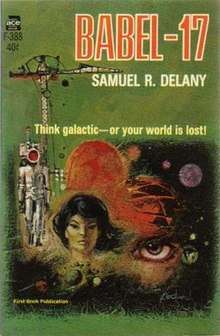Babel-17
Babel-17 is a 1966 science fiction novel by American writer Samuel R. Delany in which the Sapir–Whorf hypothesis (that language influences thought and perception) plays an important part. It was joint winner of the Nebula Award for Best Novel in 1967 (with Flowers for Algernon)[2] and was also nominated for the Hugo Award for Best Novel in 1967.[3]
 First edition | |
| Author | Samuel R. Delany |
|---|---|
| Cover artist | Jerome Podwill |
| Country | United States |
| Language | English |
| Genre | Science fiction |
| Publisher | Ace Books |
Publication date | May 17, 1966[1] |
| Pages | 173 |
Delany hoped to have Babel-17 originally published as a single volume with the novella Empire Star, but this did not happen until a 2001 reprint.[4]
Plot summary
During an interstellar war one side develops a language, Babel-17, that can be used as a weapon. Learning it turns one into an unwilling traitor as it alters perception and thought. The change is made more dangerous by the language's seductive enhancement of other abilities. This is discovered by the beautiful star-ship captain, linguist, poet, and telepath Rydra Wong. She is recruited by her government to discover how the enemy are infiltrating and sabotaging strategic sites. Initially Babel-17 is thought to be a code used by enemy agents. Rydra realizes it is a language in and of itself, and furthermore that she has a traitor on the ship. Rydra later finds that she herself is becoming the traitor as she learns more about Babel-17. She is rescued, however, by her dedicated crew, who figure out the danger and neutralizes its effects.
The novel deals with several issues related to the peculiarities of language, how conditions of life shape the formation of words and meaning, and how words themselves can shape the actions of people.
Language
The language portrayed at the center of Babel-17 contains interesting linguistic features including the absence of a pronoun or any other construction for "I". The heroine finds her perceptions (and even her physical abilities) altered once she has learned Babel-17. In this Delany's novel influenced a generation of writers: Native Tongue by Suzette Haden Elgin, The Dispossessed by Ursula K. Le Guin, Embassytown by China Miéville, "In Luna Bore Coda" by Joshua Nilles, and, more evidently, the short story "Story of Your Life" by Ted Chiang. Language as a weapon was adapted as a plot device in Neal Stephenson's Snow Crash. It also resembles a few preceding science fiction novels which deal with how languages shape the political and cultural stratum of societies, such as The Languages of Pao by Jack Vance or Anthem by Ayn Rand.
Delany describes himself as having been "a die-hard believer in the Sapir-Whorf", as expressed in Babel-17; he eventually decided that "it was just incorrect", because "it fails to take into account the whole economy of discourse, which is a linguistic level that accomplishes lots of the soft-edge conceptual contouring around ideas, whether we have available a one- or two-word name for it or only a set of informal many-word descriptions that are not completely fixed", which motivated his later works considering language: "The realization of the flaws in the Sapir-Whorf, in that they caused me to begin considering the more complex linguistic mechanisms of discourse, you might say gave me my lifetime project."[5]
Other media
In 2014, the work Babel-17 was told in tandem with a partial biography of Samuel R. Delany's early years in the form of a play The Motion of Light in Water, based on a 1988 autobiography with the same title, produced by Elbow Room, an Australian theatre company directed by Marcel Dorney.[6]
Rush drummer and lyricist Neil Peart noted that Babel-17 was one of his early literary influences, and was an important part of the crafting of the bands hugely successful 2112 album.[7]
References
- "Books Today". The New York Times: 44. May 17, 1966.
- "1966 Award Winners & Nominees". Worlds Without End. Retrieved 2009-08-24.
- "1967 Award Winners & Nominees". Worlds Without End. Retrieved 2009-08-24.
- Delany, Samuel R. (December 2001). Babel-17 / Empire Star. Vintage Books / Random House. ISBN 0-375-70669-0.
- The Art of Fiction No. 210, 2011, The Paris Review
- What if? Elbow Room’s Ray Chong Nee on The Motion of Light in Water., Theatre Works, 3 July 2014
- With Rush, Forget Ayn Rand; Think Samuel R. Delany., Rush Vault, 3 November 2013
Sources
- Clute, John; Peter Nicholls (1995). The Encyclopedia of Science Fiction (2 ed.). New York: St Martin's Press. p. 1386. ISBN 0-312-13486-X.
- Clute, John; Peter Nicholls (1995). The Multimedia Encyclopedia of Science Fiction (CD–ROM). Danbury, CT: Grolier. ISBN 0-7172-3999-3.
- Nicholls, Peter (1979). The Encyclopedia of Science Fiction. St Albans, Hertfordshire, UK: Granada Publishing Ltd. p. 672. ISBN 0-586-05380-8.
- Jakubowski, Maxim; Malcolm Edwards (1983). The Complete Book of Science Fiction and Fantasy Lists. St Albans, Hertfordshire, UK: Granada Publishing Ltd. p. 350. ISBN 0-586-05678-5.
- Pringle, David (1990). The Ultimate Guide to Science Fiction. London: Grafton Books Ltd. p. 407. ISBN 0-246-13635-9.
- Tuck, Donald H. (1974). The Encyclopedia of Science Fiction and Fantasy. Chicago: Advent. p. 136. ISBN 0-911682-20-1.
External links
- Errata for Babel-17, approved by the author.
- 2009 retrospective review by Jo Walton: "Babel 17 was published in 1966, the year in which I learned to talk."
- Babel-17 title listing at the Internet Speculative Fiction Database
- Babel-17 at Worlds Without End